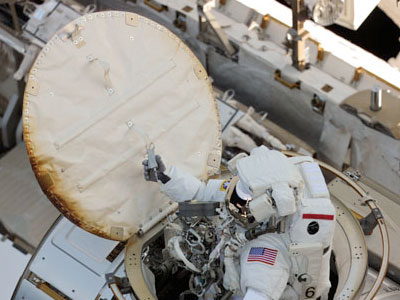|
Author
|
Topic: [ISS] Quest airlock hatch thermal cover marks
|
LM-12
Member Posts: 3208
From: Ontario, Canada
Registered: Oct 2010
|
 posted 08-05-2011 01:36 PM
posted 08-05-2011 01:36 PM
  
This photo was taken during Expedition 24. Are those burn marks on the Quest airlock EVA hatch thermal cover? How is that possible in the vacuum of space? Wouldn't any heat-related damage like that require oxygen? |
apolloprojeckt
Member Posts: 1447
From: Arnhem, Netherlands
Registered: Feb 2009
|
 posted 08-05-2011 01:36 PM
posted 08-05-2011 01:36 PM
   
Perhaps those brown spots that come from the rising sun? |
rasorenson
Member Posts: 96
From: Santa Clara, CA, USA
Registered: Nov 2009
|
 posted 08-06-2011 04:10 PM
posted 08-06-2011 04:10 PM
   
I noticed the discoloration as well and am going to take a wild stab at possible cause(s). It might be "oxidation" — for lack of a better term, of one or a combination of material "rubbing" off of the suit gloves onto the cover material and perhaps traces of atoms of gas in the hatch during the coming and going of pressurization. A combination of the two could be oxidizing — including the material of the hatch cover itself. We might assume the work environment outside the station to be pristine — but astronauts were doing things like greasing the alpha rotary joints of the solar panels. Materials on the exterior of the station will degrade or "weather" by prolonged exposure to intense sunlight. My guess is the gloves come back in dirtier than when they went out for EVA. |
rasorenson
Member Posts: 96
From: Santa Clara, CA, USA
Registered: Nov 2009
|
 posted 08-06-2011 04:13 PM
posted 08-06-2011 04:13 PM
   
Speculating a tad bit more — the edges of the hatch cover are discolored and not the center areas — including around the handle in the center — where a lot of glove-traffic would be found. It may be that material on or around the external hatch rim — which comes in contact with the cover edges, is depositing material weathered by sunlight. |
ilbasso
Member Posts: 1522
From: Greensboro, NC USA
Registered: Feb 2006
|
 posted 08-08-2011 10:14 AM
posted 08-08-2011 10:14 AM
   
My source inside MCC tells me that it's the MLI (Multi-layered Insulation) reacting with atomic oxygen. The airlock has been up there "forever", and the most discolored side is the one facing forward. That's why you see it more pronounced on that surface, rather than for example on the Canadarm, which changes its orientation regularly. He said that you see this kind of discoloration a lot with MLI that has been up there for a long time. It's the same discoloration that you see on the sides of the Shuttle. |
LM-12
Member Posts: 3208
From: Ontario, Canada
Registered: Oct 2010
|
 posted 08-08-2011 05:31 PM
posted 08-08-2011 05:31 PM
  
Thanks for that explanation. It will be interesting to see where else that type of MLI damage shows up on the station. |
LM-12
Member Posts: 3208
From: Ontario, Canada
Registered: Oct 2010
|
 posted 08-09-2011 03:48 PM
posted 08-09-2011 03:48 PM
  
It looks like the Quest airlock is going to be pretty quiet for a while. Over the next 20 months or so, there are about a half-dozen Russian-based EVAs scheduled from either the Pirs or Poisk airlocks, but only one EVA scheduled from the Quest airlock in that same period. Quite a change from the Shuttle days. |
Jay Chladek
Member Posts: 2272
From: Bellevue, NE, USA
Registered: Aug 2007
|
 posted 08-10-2011 11:13 PM
posted 08-10-2011 11:13 PM
   
That really isn't all that different from the post STS-107 stand down period. I recall only one staged EVA preformed by Expedition 6 from the American side that was done during the period until Discovery came up and docked with the ISS on STS-114. |












